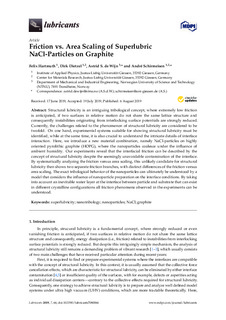| dc.contributor.author | Hartmut, Felix | |
| dc.contributor.author | Dietzel, Dirk | |
| dc.contributor.author | de Wijn, Astrid S. | |
| dc.contributor.author | Schirmeisen, André | |
| dc.date.accessioned | 2020-02-06T13:32:26Z | |
| dc.date.available | 2020-02-06T13:32:26Z | |
| dc.date.created | 2019-08-26T09:31:24Z | |
| dc.date.issued | 2019 | |
| dc.identifier.citation | Lubricants. 2019, 7 (8), . | nb_NO |
| dc.identifier.issn | 2075-4442 | |
| dc.identifier.uri | http://hdl.handle.net/11250/2640071 | |
| dc.description.abstract | Structural lubricity is an intriguing tribological concept, where extremely low friction is anticipated, if two surfaces in relative motion do not share the same lattice structure and consequently instabilities originating from interlocking surface potentials are strongly reduced. Currently, the challenges related to the phenomenon of structural lubricity are considered to be twofold. On one hand, experimental systems suitable for showing structural lubricity must be identified, while at the same time, it is also crucial to understand the intricate details of interface interaction. Here, we introduce a new material combination, namely NaCl-particles on highly oriented pyrolithic graphite (HOPG), where the nanoparticles coalesce under the influence of ambient humidity. Our experiments reveal that the interfacial friction can be described by the concept of structural lubricity despite the seemingly unavoidable contamination of the interface. By systematically analyzing the friction versus area scaling, this unlikely candidate for structural lubricity then shows two separate friction branches, with distinct differences of the friction versus area scaling. The exact tribological behavior of the nanoparticles can ultimately be understood by a model that considers the influence of nanoparticle preparation on the interface conditions. By taking into account an inevitable water layer at the interface between particle and substrate that can exist in different crystalline configurations all friction phenomena observed in the experiments can be understood. | nb_NO |
| dc.language.iso | eng | nb_NO |
| dc.publisher | MDPI | nb_NO |
| dc.rights | Navngivelse 4.0 Internasjonal | * |
| dc.rights.uri | http://creativecommons.org/licenses/by/4.0/deed.no | * |
| dc.title | Friction vs. Area Scaling of Superlubric NaCl-Particles on Graphite | nb_NO |
| dc.type | Journal article | nb_NO |
| dc.type | Peer reviewed | nb_NO |
| dc.description.version | publishedVersion | nb_NO |
| dc.source.pagenumber | 12 | nb_NO |
| dc.source.volume | 7 | nb_NO |
| dc.source.journal | Lubricants | nb_NO |
| dc.source.issue | 8 | nb_NO |
| dc.identifier.doi | 10.3390/lubricants7080066 | |
| dc.identifier.cristin | 1718570 | |
| dc.description.localcode | This is an open access article distributed under the Creative Commons Attribution License which permits unrestricted use, distribution, and reproduction in any medium, provided the original work is properly cited | nb_NO |
| cristin.unitcode | 194,64,92,0 | |
| cristin.unitname | Institutt for maskinteknikk og produksjon | |
| cristin.ispublished | true | |
| cristin.fulltext | original | |
| cristin.qualitycode | 1 | |

